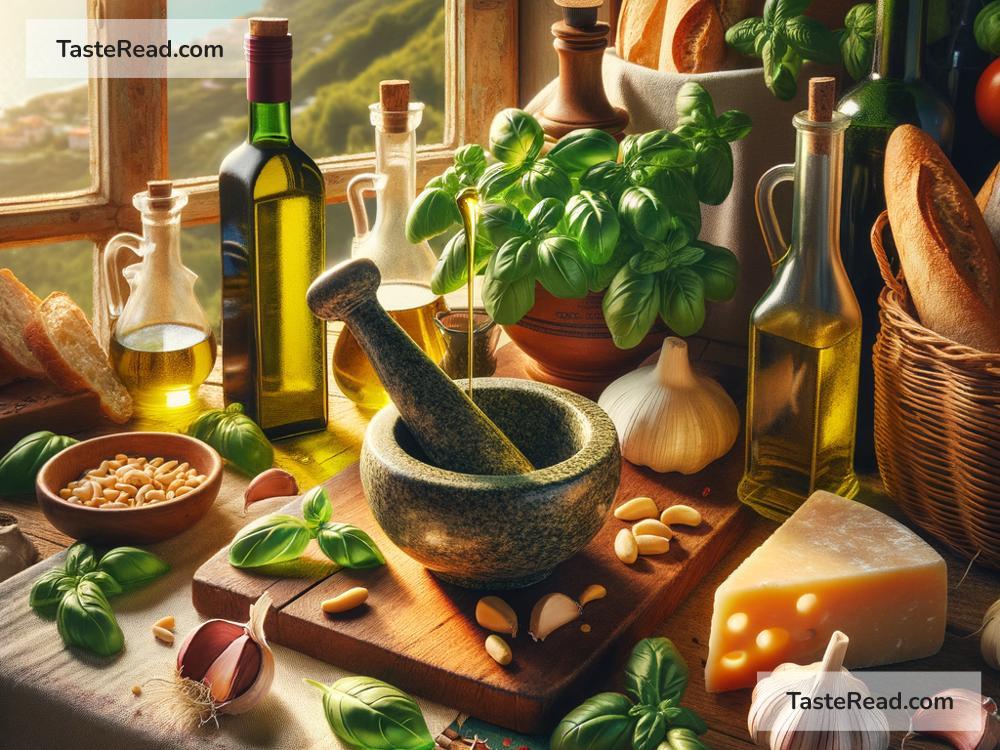Indulging in the Rustic Craft of Regional Pesto Sauces in Liguria, Italy
Nestled along the sparkling Mediterranean coastline in northern Italy, Liguria is best known for its breathtaking views and colorful seaside villages. But there’s more to this enchanting region than its stunning scenery. Liguria takes pride in its rich culinary traditions, including its famous pesto sauce—a green, garlicky delight that has won hearts around the world. In Liguria, making pesto isn’t just about food—it’s a craft, a tradition, and a source of local pride. This blog explores the rustic art of creating regional pesto sauces and why Liguria is the true home of this incredible dish.
The Heart of Pesto: Basil
Pesto, known as pesto alla genovese in Liguria, is deeply tied to local ingredients—and it all starts with fresh basil. Ligurian basil is different from what you might find elsewhere. It has small, delicate leaves and a subtle aroma that makes it ideal for sauces. Locals grow it under sunny skies and coastal breezes, and they protect its purity like a treasure. In fact, the town of Prà, near Genoa, is renowned for producing some of the best basil in the world. It’s no wonder that this simple herb takes center stage in Ligurian cuisine.
What Is Pesto Alla Genovese?
Pesto alla genovese is a classic sauce made with a few key ingredients: basil, garlic, pine nuts, olive oil, parmesan cheese, and pecorino cheese. What makes this pesto so special is the balance between these ingredients. Ligurians have perfected the art of blending them together, creating a creamy, fragrant sauce that’s both fresh and rich.
Traditionally, pesto was made using a mortar and pestle—hence its name, which comes from the Italian word “pestare,” meaning “to crush.” Though many people today use blenders or food processors for convenience, true Ligurian pesto purists swear by the mortar and pestle. Grinding the ingredients by hand releases unique flavors and textures that can’t be replicated by machines. For Ligurians, making pesto isn’t just a task—it’s a meditative ritual.
A Sauce with History
The origins of pesto can be traced back to ancient Rome, where locals made a simple paste from crushed herbs, nuts, and cheese. Over time, the recipe evolved into the pesto alla genovese we know today. Basil became the star ingredient in the 19th century, thanks to the abundance of this aromatic herb in Liguria’s fertile soil.
Pesto is more than just a sauce in Liguria; it’s part of the region’s identity. Every Ligurian family has its own pesto recipe, passed down through generations. Some might add a bit more garlic, while others might tweak the types of cheese. But one thing remains the same: the passion and care that goes into making it.
Regional Variations of Pesto
Although pesto alla genovese is the most famous type, Liguria is home to other regional pesto sauces that showcase the diversity of local ingredients. For instance, pesto di noci (walnut pesto) is made with walnuts, garlic, olive oil, and aged cheese. It’s creamier and earthier than the basil version and pairs perfectly with hearty pasta or bruschetta.
In the Cinque Terre villages, locals sometimes add sun-dried tomatoes to their pesto, giving it a reddish hue and tangy flavor. These regional twists highlight how Ligurians adapt their culinary traditions based on what’s available in their area. If you’re visiting Liguria, trying different variations of pesto is a must!
Perfect Pairings: Pasta and Beyond
Pesto is most famously paired with pasta, and Liguria has a few traditional pasta shapes specifically made to complement this sauce. Trofie, small twisted pasta, is a local favorite because it holds the pesto perfectly in every curve. Another classic pairing is trenette, a flat noodle similar to linguine. For an authentic Ligurian experience, order trenette al pesto, which is often served with potatoes and green beans mixed into the dish.
Pesto isn’t just for pasta, though. Ligurians use it as a spread on bread, a dip for vegetables, or even a sauce for meat or fish. Feeling adventurous? Try a dollop of fresh pesto on boiled potatoes—it’s a simple, yet magical combination.
Embracing the Rustic Craft
For Ligurians, pesto is not a fast food or something made in haste. It reflects a way of life that values quality, patience, and tradition. The process of making pesto by hand, using local ingredients, and sharing it with loved ones is an expression of love for their culture.
If you ever visit Liguria, you can join pesto-making classes where local cooks teach you the traditional techniques. You’ll get to use a mortar and pestle to make your own sauce—a hands-on experience that connects you to Ligurian food heritage. It’s about more than learning a recipe; it’s about appreciating the timeless craft that makes Ligurian pesto so special.
Bringing Liguria to Your Kitchen
The beauty of pesto is its simplicity, which means you can make it at home even if you don’t live in Italy. To create an authentic Ligurian pesto, try to use high-quality ingredients like fresh basil, extra virgin olive oil, and aged parmesan. And if you’re feeling committed, skip the blender and try the mortar and pestle method. It might take extra effort, but the vibrant aroma and rich texture are worth it.
By indulging in the craft of Ligurian pesto, you’re embracing a piece of Italy’s culinary soul. Whether you enjoy it with pasta, bread, or something else entirely, each bite is a celebration of the flavors and traditions that make Liguria so unique. Now, gather some basil and start pestare—the spirit of Liguria awaits in your kitchen!


